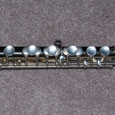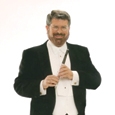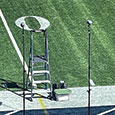Editor’s Note: Jan Gippo was the first Let’s Talk Picc columnist and wrote the piccolo features for over 15 years.
A friend and I were talking about the coming work week, and I mentioned that I was writing an article about the 30 best piccolo pieces. Although my friend is a musician, I was shocked when he stated in all earnestness, “I didn’t realize there were 30 piccolo pieces.” In the music stacks in my studio I have 378 piccolo pieces, and that number does not include the piccolo and band type polkas and theme and variation pieces I have uncovered.
So with my friend’s statement in mind, I offer here a list of 30 piccolo pieces I believe to be the best representation of the music of the last 30 years. All works are listed alphabetically, and the list does not represent a ranking of any sort. If you believe that I have missed some good pieces, please contact me with the name of the piece, composer and any contact information you might have.
Piccolo Solos
Samuel Adler, Canto XIII is the 13th in a series of solo pieces written for instruments of the orchestra. This fine piece is based on a Gregorian chant and is a theme and variations with the performer moving across the stage to three different stations each time the chant is played.
Martin Amlin wrote two very lovely pieces for Regina Helcher called Ephemeroptera I & II. Hard name, easy pieces. Good to start a program.
Lowell Liebermann was commissioned by Sarah Baird Fouse to write a piece for bass flute. When I saw the manuscript to Eight Pieces, I asked if he would mind if the piccolo also had it in our library, and he agreed that the entire flute family could play it. Each movement is a jewel. This piece should be in all flutist’s repertoire.
David Loeb spends half of each year in Japan and has become a master at writing Eastern rim melodies for piccolo. I have picked three that give the best representation of his work.
Six Preludes: Studies on East Asian Pipes for solo piccolo has eight melodies, each one from a different country in the Pacific Rim.
V Preludes for Solo Piccolo, Vol III has six pieces, all fantasies and melodies created by Loeb.
The Three Tibetan Fantasias are yet another style and as interesting as they are different.
Vincent Persichetti’s Parable XII for solo piccolo was one of the first new pieces written for piccolo (1973). It is the 12th of his Parables, and like Sam Adler, he carrys on the tradition of Paul Hindemith of writing at least one piece for all the instruments.
Karlheinz Stockhausen has written a very long opera called Saturday, from Light. In it is the Tip-of-the-tongue Dance, a very difficult and avant-garde piccolo solo.
Will Gay Bottje’s Concertino for Piccolo and Orchestra is the first piccolo concerto since the Vivaldi concertos. Written in 1955 for Walfrid Kujala, it is harmonically in the tradition of post-romantic American music. Almost forgotten, piccoloists should rediscover the piece and give it its place in the history of piccolo music.
Bruce Broughton is a very successful composer. His best known film score is Silverado. His Concerto for Piccolo and Chamber Orchestra is the first major concerto written for piccolo and has been played by many professional performers. A band adaptation of the orchestral score is also available and has had at least 15 performances. A very lovely second movement in Baroque style is flanked with fast and technical outer movements.
Lowell Liebermann has written seven pieces for flute/piccolo/bass flute. The Concerto for Piccolo and Orchestra, Op. 50 is the most popular of the piccolo concertos and is one of Lowell’s finest efforts. It has had close to 75 performances with major orchestras throughout the world and numerous performances by regional and college orchestras.
Martin Amlin’s first flute sonata, recorded by Leone Buyse and Amlin, is an excellent recording showing how his rhythms can be performed flawlessly. The Concerto for Piccolo and Orchestra was premièred by Carl Hall and received with cheering applause. Another great success for Martin Amlin.
Amlin has also written a Sonata for Piccolo and Piano and a Sonatina Piccola. The Sonata’s first movement is the most sophisticated rhythmic work I have ever played, and although it is very difficult, it makes complete musical sense when each performer plays the rhythms seamlessly. It is a must for any repertory list.
Robert Beaser’s Souvenirs is a six-movement work that incorporates his well-known free transcription of the mountain song “Cindy” and an homage to 911. It is a little-known piece of immense musical passion.
Zart Dombourian Eby of the Seattle Symphony sent me a recording of Ken Benshoof and an unknown piccolo player performing his piece Spindrift. Benshoof is mostly a jazz player so the entire piece was improvised. Benshoof and I worked long hours to get the right sound and style put into written music. We were successful and now there is a jazzy piece that is a hoot to play.
Laurie Skoloff of the Baltimore Symphony commissioned Michael Daugherty’s The High and The Mighty, which is a modern work with melodies and special effects, especially the simultaneous humming of the tune while playing. A fun piece, it is very difficult but well worth the work to get it performance ready.
Daniel Dorff’s Sonatine de Giverny was inspired by the painting of the garden area of Giverny where Monet painted his famous Water Lilies. The work is an excellent example of French writing and is in the Paris Conservatory style, with the exception of its being three delineated movements rather than the usual French one- movement piece.
Stephen Kujala wrote a very jazzy, rhythmic, difficult piece called Eurhythmionics. Years before he had written Take Your Picc, which his father asked him to expand into a piece he could play at an NFA Convention. Eurhythmionics was the result; it doesn’t sound much like its first attempt, but it is extremely fun to conquer and play.
Mike Mower’s music is fun, happy, jazzy, and easy to understand. This Sonata for Piccolo and Piano is in the same style and is a good piece that isn’t too difficult or serious.
Peter Schickele is just plain zany. In his Sonata Piccola he uses the performers as actors doing funny skits, such has having the pianist put her fingers in the piccoloist’s ears as she tries to hit a high C. Schickele is a genius at the musical gag and this piece is ours. It would be excellent for a young people show or to just break the ice at a stuffy recital.
Stephen Hough, the extraordinary pianist, is also a fine composer. At the request of the piccoloist of the Berlin Philharmonic, Hough wrote a piece for piccolo, contrabassoon and piano that is tonal, somewhat fast in parts, but enjoyable. The hook of course is the difference in octave, timber, and sound of the two extremes from the woodwind family.
Ken Benshoof piccolo quartet In Shadow, Light (piccolo, violin, viola, cello) is the only quartet for piccolo that I know, and like Spindrift, is somewhat jazzy, but in general much more mainstream and extremely well-written. It has a wonderful sound and is great fun to work with string players in a traditional form.
My wife, a world-class clarinetist, suggested a recommended list of one piccolo composition for each of Flute Talk’s 30 years.
1980: J.J. Werner, Nachstuck and Bun-Ching
1981: Bun-Ching Lam, Bittersweet Music I
1982: Michael S Horwood, Birds for piccolo, piano, and colour slides (A must for any flute/piccolo player)
1983: John Adams, Songbirdsongs Book I & II
1984: Masanoro Fiujita, Hagi-no-Soyogite for piccolo, alto flute, vibraphone, marimba
1985: Paul Agricole Genin, Fantasie sur “Il pleu, il pleu, Bergere”
1986: David Loeb, Four Preludes: Studies on East Asian Pipes, Vol. 2
1987: Josef Alexander, Three Miniatures for Two Extremes (picc and tuba)
1988: Trevor Wye, Patricia Morris, A Piccolo Practice Book. (The best of its kind.)
1989: Jay Vosk, Aerobatics for two piccolos
1990: Shelley Foster Gurin, Sentiments for Piccolo (also for band and piano)
1991: Donald Erb, Drawing Down the Moon (the best piece for piccolo and mallet percussion)
1992: Alan Ridout, Farndale Dances for piccolo solo
1993: John LaMontaine, Sonata for piccolo and piano, Op. 61
1994: Marilyn Bliss, Rima
1995: George Tsontakis, Il Fervore
1996: Wolfgang Witzenmann, Sonata for piccolo and piano
1997: Robert Cronin, Portraits for piccolo and piano
1998: Jessica Daniels Kozlowski, Acrobatics: A Suite for Piccolo and Piano
1999: Roberto Casado, Elkarrizketa for 2 piccolos and tambourine
2000: Stephen Mager, Illuminations: Middle English lyrics for soprano, piccolo and harp
2001: Regis Campo, Le Pic-Vert pour flute piccolo et piano
2002: Aldo Kumar, Graffiti for piccolo and piano
2003: Yoram Meyouhas, Bagatelles for piccolo solo
2004: Peter Kopac, Animula Vagula Blandula for piccolo, bassoon, and piano
2005: Daniel Kelley, Suite for piccolo and piano
2006: David Loeb, Nightcolors for Piccolo Solo
2007: Daniel Felsenfeld, All Work and No Play
2008: Stephen Hough, Was mit den Tranen geschieht (What happens to the tears)
2009: Eric Ewazen, Wildflowers, trio sonata for piccolo, clarinet, and piano
2010: Eric Ewazen, Concerto for Piccolo and Orchestra (band)
Have fun learning all these pieces and performing them, because the piccolo repertoire is growing, and by the time you are finished learning these 30 works, there will probably be 60 more.






